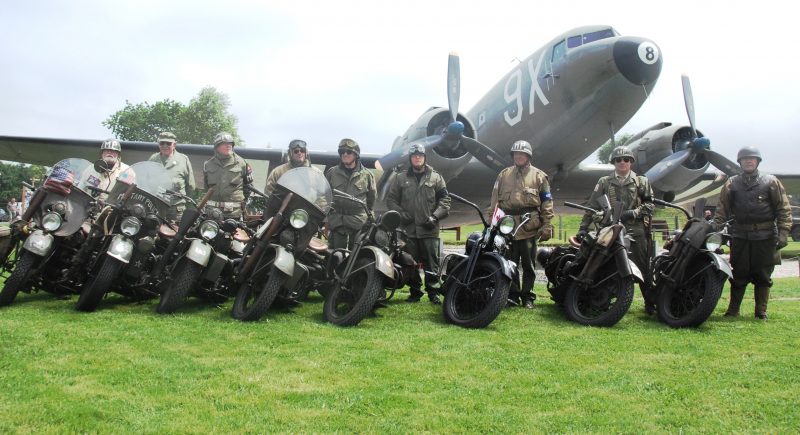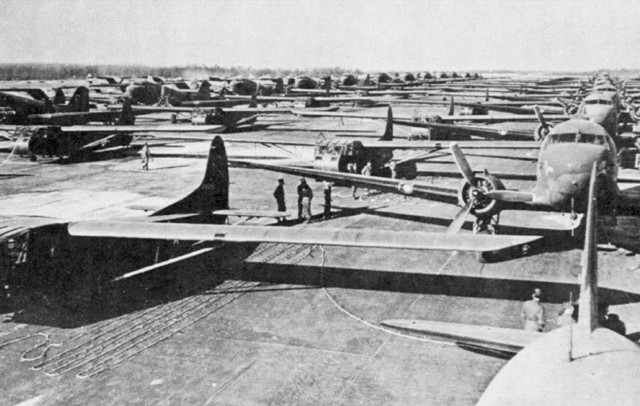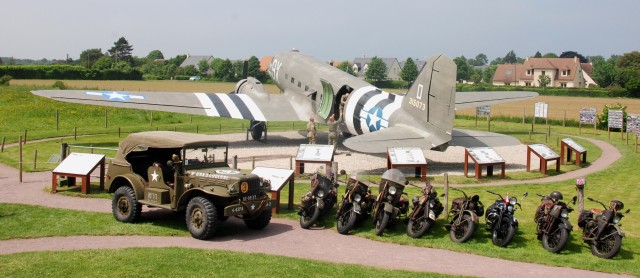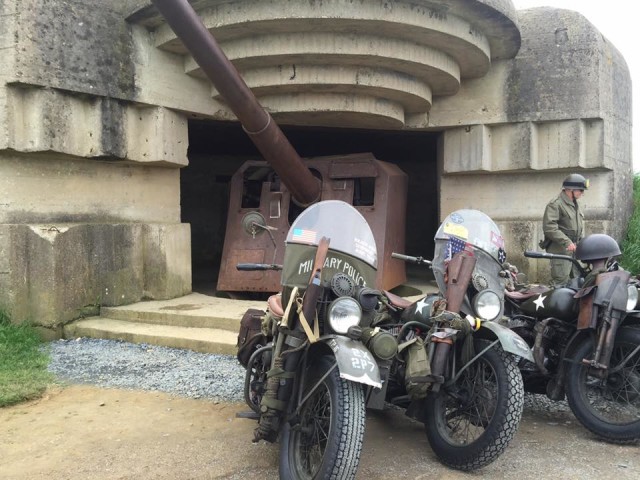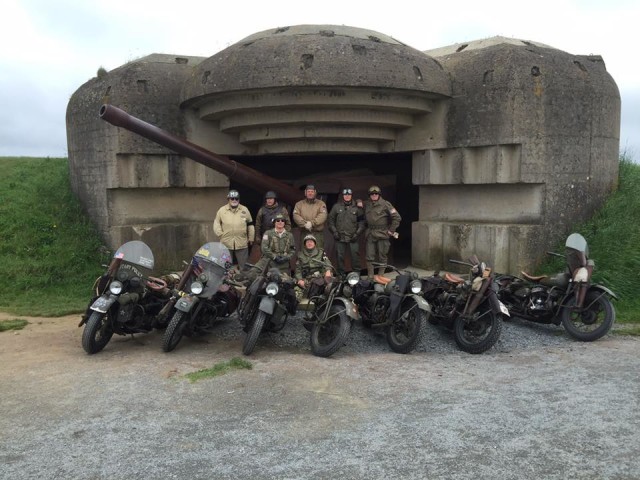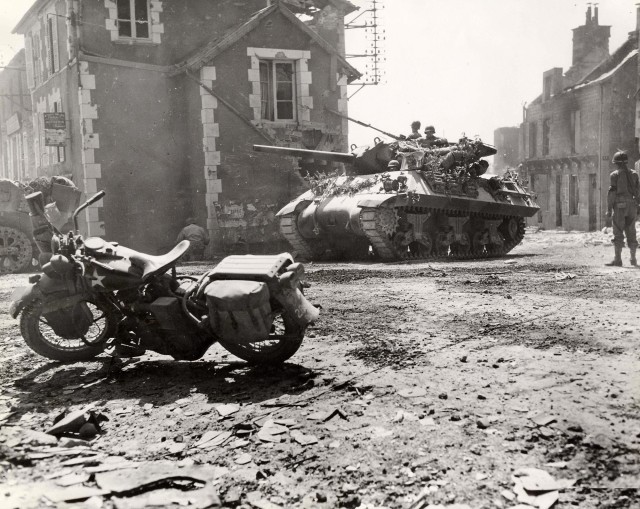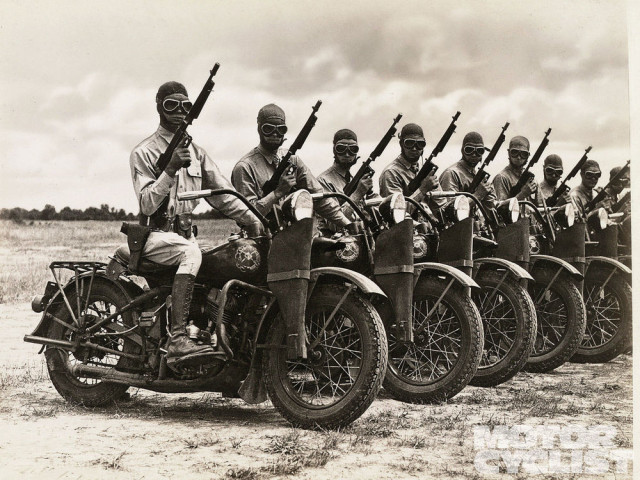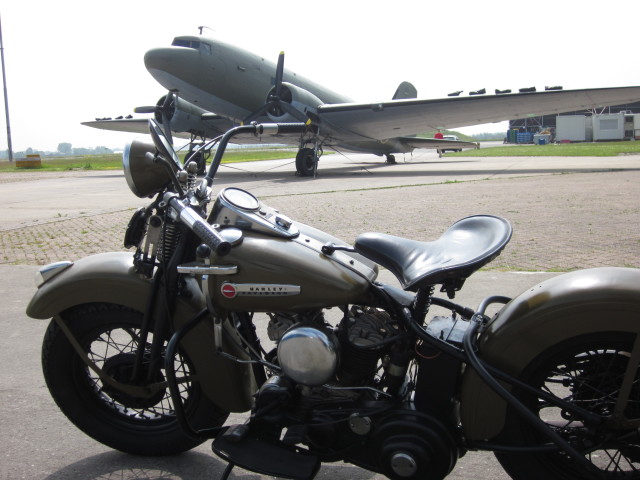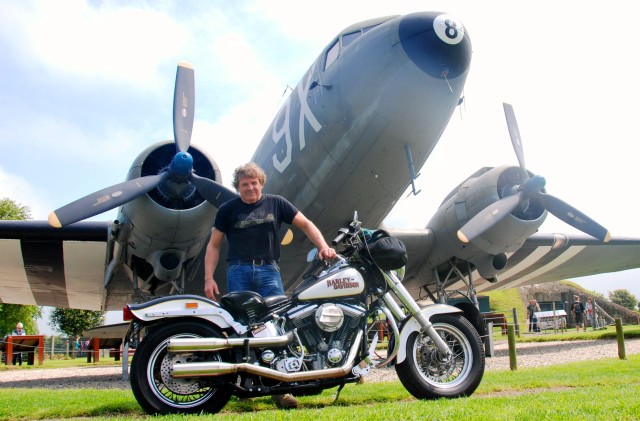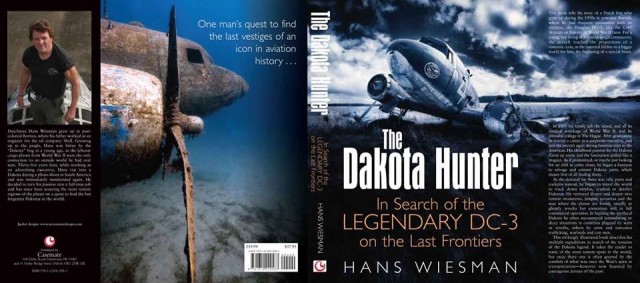This Dakota Hunter Blog is a report of our Harley Club’s visit to Normandy. This year, on 4th June 2016, we gave an “acte de presence” at the “Batterie de Merville” Museum. With the Wartime built Harley Davidsons WLA/ WLC types and a Dodge Command car, we brought a tribute to a legendary D-Day veteran Douglas C-47/ Dakota. This contemporary workhorse C-47 was named in its heydays the “SNAFU Special” (Systems Normal, All Fouled Up) and that name, evidently, is applied again on its cockpit LH side, along with that most original 8-ball nose-art and the white “Invasion- striping” over the wings and the tail.
The feature photo depicts the SNAFU Special with the entourage of 8 Harley Davidsons from Holland that rode in for the D-Day commemorative “Ceremonies Protocolaires”. From left to right, you’ll see standing behind their Harley’s: Ceel Navest, Frits Al, Andrew Beute, Edwin Tummers, Ron Vogel, Willem Buchly, Ted Laros, Gijs Goudkamp and André Arendse, all of them avid Harley riders and many also expert Wrench Jocks. (Photo courtesy Rob Lambij and special thanks to Hans Combee for his patience and intermediate role in getting the motor gang on the Holy Grounds in front of their Relic /Gate Guard/ Monument)
This SNAFU Special aircraft has a most remarkable and well-documented history since its birth in January 1944 in the USA as a war plane. This aircraft would soon take part in all major European Airborne war operations from early 1944 until the very end of the war in May 1945 and beyond! With Para droppings and Glider towing she participated in Operation Neptune (the D-Day cross-Channel phase of Operation Overlord) on 6 June 1944. But also in Dragoon (landings on 15 August 1944 in Southern France), Market Garden (September 1944 , over Arnhem, Holland, “a bridge too far”), Repulse (Bastogne, 27 December 1944 with Combat /Cargo Gliders) and finally Operation Varsity (24 March 1945, C-47’s /Dakotas of No. 46 Group crossing the Rhine for reaching their dropping zones, the last airborne deployment with Gliders of WWII , see photo below, the SNAFU Special is among them!).
Photo above depicts the preparations for Operation Varsity, March 1945, in which the SNAFU Special participated. The aircraft had a most impressive military career with its engagement in so many airborne operations. In 1946, its military role ended as the aircraft was sold to the National Tcheco-Slovakian Airlines. But in 1960 , the aircraft re-entered Military Services with the French Air Force. In 1971 , it was sold to the Yugoslavian Air Force and ended up in Bosnia at the Rajlovac Air Force Base. As a derelict aircraft, it was used by the peacekeeper pilots during the Yugo Wars 1991-1999 as a bar/canteen, named the Dakota Club. During the conflict, the airframe received over 250 bullet holes and was considered a total loss at the war’s end.
Photo above shows the SNAFU Special from behind at the verge of the Museum’s perimeter. Next to the Harleys and the Dakota, you´ll see the Dodge Command Car in an immaculate state, owned by Robert van Dongen. This same field still houses a number of huge cannons in Bunkers, recessed from the Beach, that could easily cover the Landing Beach “Sword” at some 7-8 miles distance. A British Commando team commanded by Lieutenant Colonel Terence Otway was sent in by Gliders towed by Dakotas on the night before the landings would take place. Their task was simple but very dangerous: this lethal 120 mm Gun Battery had to be knocked out before they could come to action at daybreak. The 9th Parachute Battalion and part of the 3rd Parachute Brigade, along with Sappers and a company of the 1 st Canadian Parachute Battalion took part in the assault on the heavily armored casemates , defended by 100 German soldiers. In a chaos of troops that lost their way to make it to their targets, the Brits and Canadians fought a heroic battle and accomplished their mission right in time. (Photo courtesy Rob Lambij)
One day, the C-47 SNAFU Special in Bosnia was “detected” as being the D-Day veteran of that name. In a special operation, with the help of Ambassadors, the Merville Museum Team went to Bosnia by late 2007, dismantling the airframe and engines. They put it all on transport to France with 3 huge flatbed trucks that arrived in Caen in December 2007. After a year of refurbishing the damaged aircraft, it was installed in May 2008 in Merville on its current show place.
If you ever come to La Douche France, you should absolutely visit this area with all its museums, relics and bunkers. It is the biggest and most interesting Open Air War Museum in the World. And, free of charge, there is the omnipresent parade of WWII Vehicles, Tanks, and Aircraft, Para droppings, thousands of men in a wide variety of Military uniforms , as if you walk right into a Steven Spielberg War Movie scene. It is all for real, no Taiwan made replicas. And inside the SNAFU’s cockpit, you’ll find the steering wheels mounted on the Yoke. Guess where that comes from? It was the painfully missing part they could not find, a wooden mock-up was maybe considered to fill the conspicuous gap. But right in time, The Dakota Hunter walked in in 2010 and brought them the missing Yoke, which was recovered a year earlier by him in the Amazon Jungle from a seized Colombian Drugs Runner Dakota.
Photo above depicts 3 of the Harley Davidson WLAs in more details, with holsters, ropes, leather bags and ammo drums, exactly copied from the wartime photos, including the letter types, tank emblems, but also the uniforms, helmets, weapons and boots that they wear during their rides to/ in the military parades. The Cannon in the backdrop is part of the Longes-sur-Mer Batteries, just West of Arromanches in the heart of the Calvados region, Normandy. For whatever reason, while many casemates and fortifications in Holland and Belgium have been demolished, buried or closed for public entry, most Bunkers in Normandy are considered part of their Wartime Heritage and kept intact, open and dressed up with Guns, Cannons etc. A different approach, conserving, maintaining and magnificently displaying the Historic Value of the Atlantic Wall for Tourism. Bravo.(Photo Gijs Goudkamp)
Photo above (courtesy Gijs Goudkamp) was taken in the same Longues-sur-Mer Bunker in Normandy, June 2016. Wherever those “Harlistas” go, their presence and siren supported appearance always draws massive attention from the public. Not only here in France, but also in The Netherlands, where similar yearly WW II commemorations take place. The huge number of surplus Harley’s that was publicly sold in Holland and Belgium right after WWII accounts for the relatively high number that survived in the Lowlands where they were baptised as the Liberators. With abundant stocks of spare parts, the low-tech V-Twin engine motorcycle is much sought-after, pushing the market value of most Harley WL types in original state well over Euro 10.000.
Photo above, showing a Harley in what seems a typical French setting. Right after D-Day , the rapid Allied advance from the 5 Landing Beaches found major resistance in the cities like Caen and Carentan. In Caen, tanks were engaged in fierce battles that finally destroyed 30 % of the city. The motorcycle riders were there for leading the convoys, traffic control, and direction finders in totally annihilated city-centers which left no clues for orientation. The WLA and its Indian competitors went to numerous Allied armies under Lend-Lease or direct contracts. These countries included Canada (which received its own distinct Harley-Davidson model, the WLC with the “high” Headlamp), the United Kingdom, Australia, New Zealand, South Africa, India, Polish forces in exile (under both British and Soviet command), France (Third Republic and Free French forces), Brazil, and the Republic of China. All in all, some 88.000 Harley Davidson WLA types were produced during the war years , while the Douglas C-47/ Dakota came to 10.000 aircraft produced in that war.
Photo above shows soldiers armed with the Thompson Military M1928 Sub Machine Guns, without the 30 rounds straight “Stick” magazine inserted. Note the fork mounted leather holsters, the open fenders and the special badge on their Tanks. Any clue who they were? You please let me know. The engines were 750 cc side valve V-Twins, designed many years earlier and both used by Harley and Indian. The side valve setup was relatively simple to build, but yielded low fuel efficiency and HP output. In contrast, it was a reliable motor and also commonly used in the Automotive Industry (Wartime built Jeeps also had side valve 4-cylinder engines). Just before, during and after the War, Harley designed the Overhead Valve configuration for its engines as most German brands had since years. Their engine displacement went from 750 to 1000 cc, to 1200 and 1340 cc . In the new age, Harley arrived at 1700 cc for their V-2 Big Twin models and their V-2 Sportsters Models have displacements of 900/ 1200 cc.
The photo above depicts a 1947 Harley Davidson 750 cc V-Twin in a post-war Civilian version, named the Victory. It is owned by my friend Bally Nienhuis and is as original as can be with the skirted fenders, the color, the high headlamp. larger tank , dash, shiny air filter, and the newer model gearbox/ gearshift bracket mounted on the tank. Those 16-inch wheels were optional, as was a larger duo saddle with auxiliary springs and rear handgrips .
As a student starting at Rotterdam University , I bought my first Harley WL Flathead in 1967. That one was exactly like the one on this photo. I paid for that motorcycle the sum of 550 Guilders, equivalent of US $250 . It was the cheapest transport I could buy but gave me the time of my life with an immense Freedom to move around all over Europe. Since my kid years in Indonesia, I was bitten by the Dakota and Harley Bug and would stay “fidel” to the Milwaukee Made Motorcycle for the rest of my eventful life. (OK, I admit, I made a side step to a KTM GS 400, a savage Offroad bike that brought me twice a broken leg and a broken shoulder during the fast Beach runs. It was enough to quit and I returned in 1985 to Harley with the bike shown in the photo below.)
Photo above was taken in Merville 4 June 2016 ( Photo Rob Lambij). I went there with the Club on my Harley FXST Softail. I bought this one in 1985, brand-new as the first EVO model that came to Holland. Its 1340 cc engine retains the fabulous V-twin architecture of the vintage Harleys, be it with more displacement, overhead valves, and a lot more HP output. This EVO engine and Softail frame made the Harley factory resurrect from its imminent ” Days of Doom” in the mid-1980’s. Many anticipated the end of Harley’s existence as yearly sales dropped to less than 60.000 bikes. Note that this bike still has the Factory mounted 4-gearbox (there was a small inventory of 5000 old model Shovel gearboxes still on the shelf, so they coupled them for economical reasons to the first series of the Early Evos, built only by end 1984). With that I bought a rare bike, only 2700 built and it gave me the legendary kick starter and secondary chain (no Belt drive) of its predecessor with the Shovel Engine, once reputed as a capricious block, but now raising again to cult status. Detail saillant, this bike of mine was stolen at The Cote d’Azur in France in 1990. It was found back in 1993 and ever since I rode it all over Europe, USA and Canada. With more than 100,000 miles on the clock, this EVO engine is still running with its original ball bearings, the crankcase and gearbox have never come apart. Only piston rings and cylinder gaskets have been replaced in 31 years of 100% FUN. Most reliable Bike that I ever rode. The bike quit only once, right in the heart of Death Valley, California with some 50 degrees Centigrade. A very tiny coil in the ignition cone had a sort of meltdown and gave intermittently a spark when cold and no spark or a loud bang when hot. Only in Mendocino, I found the medicine for my coughing bike. At 100 miles North of SF on our way to Vancouver, a Compu-Fire was installed. As you will understand , this bike has been a crucial part(ner) of my wandering life over the past 30 years. No way to ever part from this Milwaukee Magic Machine again, I will ride with her until the end of (my) Time, she came and will come with me thru the faraway Gates of Wonder, whenever they open up.
Are you interested in these subjects and stories? May I recommend you my book The Dakota Hunter, published by Casemate from NY, USA and Oxford, UK. My book is an engagingly written report of my passions and the adventures I encountered: 320 pages illustrated with 250 unique photos, all made during my 25 years of expeditions to the remote places where the last of the WW II built aircraft still struggle for survival. Meet the Dakotas/ C-47s , the PBY-5 A Catalinas, Commandos/ C-46s and other vintage aircraft that I flew and that still fly in remote places. Meet the pilots, the owners, the Military and the War Lords, who use the planes for their trade and transport. But also the war history of those aircraft that I found crashed in the Jungles of the Amazon, the Yukon mountains etc.
For ordering this book, you can go directly to the Amazon page by clicking here at Ordering at Amazon The Dakota Hunter Book. For previews,5-star reviews of my book The Dakota Hunter, scroll down on the Amazon page. For my earlier Blogs, click here at dc3dakotahunter.com. If you like authentic tales about vintage aircraft & their war history, read one of my most successful Blogs here about the PBY-5 Catalina that I flew as a young kid over the Jungle and rivers of Borneo. Click Dakota Hunter Catalina Photo Album.
Below you’ll see the jacket/ cover design of my book.
